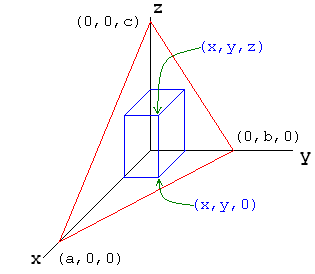This page walks through solving the classic truncated triangular room problem,
stated in general terms. The problem is to find the dimensions and size of the
largest rectangular box that can be constructed in a truncated triangular room of given dimensions.
Such a triangular room has right triangles for its floor and two walls. An image of such a room,
placed at the origin of a rectangular coordinate system is:

We will solve this problem twice. First, we will solve it by the brute strength and awkwardness
techniques of expressing the volume as a function of `x` and `y`, and then finding ordered pairs `(x,y)`
that produce zero values for the two partial derivatives of the function.
From there we can determine the `z` value and the volume.
After that, we will solve it again using the method of Legrange multipliers.
|
`yz = lambda bc`
| (4) |
|
`xz = lambda ac`
| (5) |
|
`xy = lambda ab`
| (6) |
|
along with the equation of the plane (i.e., the constraint)
|
|
`bc x + ac y + ab z = abc`
| (7) |
|
We solve (4), (5), and (6), respecively, for `lambda` giving rise to:
|
|
`(yz)/(bc) = lambda`
| (8) |
|
`(xz)/(ac) = lambda`
| (9) |
|
`(xy)/(ab) = lambda`
| (10) |
|
Using (8) and (9) we have
|
|
`(yz)/(bc) = (xz)/(ac)`
`y/b = x/a`
`a/b y = x`
| (11) |
|
Using (9) and (10) we have
|
|
`(xz)/(ac) = (xy)/(ab)`
`z/c = y/b`
`z = c/b y`
| (12) |
|
Then, rewiting (7), but substituting `a/b y` for `x` and `c/b y` for `z`
|
|
`bc(a/b y) + ac y + ab(c/b y) = abc`
`acy +acy +acy =abc`
` 3acy = abc`
`y = 1/3 b`
| (13) |
|
Subsituting (13) into (11) gives
|
|
`x = a/b (1/3 b)`
`x = 1/3 a`
| |
|
Subsituting (13) into (12) gives
|
|
`z = c/b (1/3 b)`
`z = 1/3 c`
| |
|
And, of course, all of that gives
|
|
max volume is at `(a/3, b/3, c/3)` and that volume is `(abc)/27`
| |
